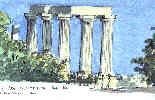Journey through Ancient Greece
Ancient Corinth

Journey through Ancient Greece Ancient Corinth |
|
| Corinth stands
on a site occupied since Neolithic times, well before
3000 BC. No other city in ancient Greece held so
commanding a position; its location on the Isthmus of
Corinth allowing it to control the traffic between north
and south. Being a leading naval power as well as rich commercial city enabled ancient Corinth to establish colonies in Syracuse on the island of Sicily and on Corcyra, now Corfu. These colonies served as trading posts for the richly ornamental bronze works, textiles, and pottery that Corinth produced. Beginning in 582 BC, in the spring of every second year, the Isthmian Games were celebrated in honour of the sea god Poseidon. Here at the games of 336 BC the Greeks chose Alexander the Great to lead them in war against the Persians. The Romans destroyed Corinth in 146 BC. A hundred years later Julius Caesar rebuilt it, and again it became a prominent commercial city. About 51 AD the apostle Paul came as a missionary to Corinth, founded a church here, and addressed his Epistles to the Corinthians. A canal through the isthmus was begun by the emperor Nero in 67 AD. Wielding a gold shovel, Nero himself was first to break ground, but the canal was not completed due to the collapse of the canal sides. Up to the 12th century, ships were dragged on rollers across the isthmus. A 4-mile canal was completed in 1893 providing an essential shipping route between the Ionian and Aegean seas. The small museum at the site has many interesting statues, mostly Roman, and some good examples of Corinthian pottery. The 6th century BC archaic temple to Apollo replaced a 7th century temple. Its' monolithic pillars (i.e. made in one piece) dominate the site; this is one of the only two remaining Archaic temples. According to Pausanius (the Baedeker of the 2nd century AD) there was a bronze statue in the temple. The Agora, one of the largest in Greece, was paved with marble slabs. The Romans redesigned it in 146 AD making it smaller and paving it with cobbles. In the centre of one row (the central shops), is a platform, the Bema , from which speakers, including St Paul, addressed the people. Leaving the site by the ancient paved Lechaion Road you will pass the Fountain of Pirene built by Herodes Atticus in the 2nd century. (Herodes was fond of water features and also built the Nymphaeum at Olympia.) During the Roman period the fountain was one of the most impressive features of Corinth. There is also a rather friendly 20 seat latrine! |